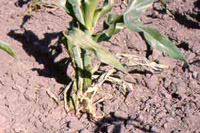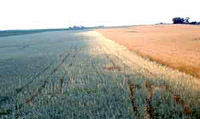Chinch Bug
Blissus Leucopterus

Figure 1. Chinch Bug Adult
Description
The adult chinch bug has a black body, brown
to reddish yellow legs, and white wings that have a triangular black
area in the middle of the outer margin. The insect gives off a
distinctive foul odor when crushed. The eggs, yellow when first laid,
turn red before hatching. They are tiny, elongate, and about four times
as long as broad, with four short, nipple-like projections on the cap.
Although laid singly, they can be found in clusters at the base of the
host plants among the roots and soil and also behind the lower leaf
sheaths. The nymphs are tiny red to dark red or nearly black creatures
with a yellow to white traverse band on the body. This band remains
apparent through successive molts even though the body color darkens.

Figure 2. Chinch Bug Nymphs on Corn
Life Cycle
There are two generations each year. The adults
winter in grasses and other ground cover on the south and west sides of
wooded areas and along roadsides. The preferred wintering hosts are
native.grasses like big and little bluestem. In warm days in the spring
the bugs fly from their winter quarters in search of a suitable host
plant field. At this time they prefer small grains, timothy,bluegrass,
millet, sudan grass, or any of the other grasses. The thinner and more
open the stand, the more preferable it is to the adult chinch bug. This
search for a suitable field for feeding and egg-laying may require
several days or even weeks.
Egg-laying occurs in late May or early June. During this time the insects mate repeatedly, each female laying a few eggs a day. Each female is capable of laying 200 or more eggs over a month's time. It takes about a month from the time the eggs hatch until the insects are mature. Since egg-laying covers a period of a month, some of the first-generation bugs may develop wings while others are still small. All of this development occurs in small-grain or grass fields.
About the time that the grain is beginning to dry, the bugs start to migrate. They will feed on any grasses, but they are particularly damaging to corn. After becoming adult, they may not fly for several days. Eventually they concentrate in areas in cornfields that are weak or stunted. Here another generation develops, and the adults move out in search of hibernating quarters during October.
Damage
This insect is a native species and is largely
concentrated up the upper Mississippi Valley and its tributaries. In
years of serious outbreak, damage has gone into millions of dollars.
Chinch bug damage in a small grain field first appears as small spots of drying grain. These areas gradually enlarge until, under severe infestation, an entire field may be affected. In corn, first the lower leaves and then the whole plant wilts and soon turns white. Damage resembles that caused by severe frost or fire. This condition continues into the field as far as the heavy infestation. Some bugs, however, may be found on plants 50 to 100 rows beyond the furthest point of visible damage.

Figure 3. Damage to Corn
Damage thus ranges from complete crop loss in severe infestations to no damage in light infestations. Since the bugs are small, most plants can tolerate a moderate number of them. Damage occurs, however, when hundreds or thousands of them mass on individual plants.

Figure 4. Damage in Wheat and Oats
Scouting Procedures
Scout small grain fields adjacent to
cornfields as they become mature. Look for chinch bugs in these fields.
If chinch bugs are found, watch closely for migration from these fields,
especially as the grain ripens and harvest approaches. Likewise, pay
particular attention to border rows of cornfields adjacent to small
grain fields. Inspect 100 plants (20 plants in five locations in the
outer two rows).
Threshold Guide
There is no specific threshold for chinch
bugs since they rarely cause economic damage unless they occur in large
numbers. Treat at first migration and when damage begins to occur.
Things to Know
Chinch bugs have not disappeared, as some
people believe. Some are found in all areas of Illinois each year. Since
they prefer sunny, dry conditions, two successive years of drought
usually prove that they are still with us.
During the past few years a definite relationship has been noted between small grains on soybean ground and chinch bug abundance. In heavy soybean trash, the grain stand is apparently light and open, a condition favoring chinch bugs.
Heavy undergrowth of legumes in a grain field discourages chinch bug infestations since the bugs cannot survive in shady, humid conditions. In the spring adults concentrate in a field that is favorable to them, but vigorous growing conditions soon make it unfavorable. Adults have been observed migrating from these fields to congregate in a few of the outer drill rows, where it is more open and sunny, or to adjacent fields of thin stands of grain. Adults leaving winter quarters in large numbers attack and seriously damage tiny small grain like late oats, unthrifty wheat, or barley. They may also attack small corn and cause it to wilt. It may be necessary to apply insecticides if the old overwintering bugs are damaging areas in these fields.
Chinch bug nymphs that hatch from first-generation eggs laid on corn cannot survive because they apparently require a small grain or grass in their diet first. Eggs are laid on corn, however, and small bugs are continually hatching and replacing those that die. This continues until all eggs have hatched. Thus, insecticide treatment is rarely necessary to control the newly hatching firstgeneration bugs on corn. It is not known why first-generation nymphs cannot survive on corn unless they first have a small grain or grass in their diet. However, if they feed upon a small grain or grass for a few days first, they are then capable of surviving on corn. When one of the grasses or small grains infested with chinch bug eggs is plowed under and planted to corn, survival of nymphs on the corn is good, because they have fed on the grain growth. In this case insecticide control may be necessary.
When bugs are migrating from the grain or grass field, they often go through a soybean field. They do not feed on the bean plants, but often kill all of the foxtail and volunteer corn. Occasionally they will even kill the foxtail in a cornfield and not feed on the corn. It is believed that chinch bug survival is correlated with the nitrogen content of plants. Survival is greatest on plants having a nitrogen deficiency.
Natural Control
A fungus disease that kills chinch bugs
during periods of humid weather can almost eliminate a large population.
High temperatures and moisture are necessary for this fungus to give
maximum control. When most of the bugs are newly hatched, or at least
very small, hard beating rains will trap them in the mud, from which
they cannot escape. Weather is one of the most important natural
controls of chinch bugs. Hot, dry, weather is favorable, while warm,
humid weather is detrimental. The thickness of grain stands and the type
of plant growth are usually more important than the kind of grain in
the field.